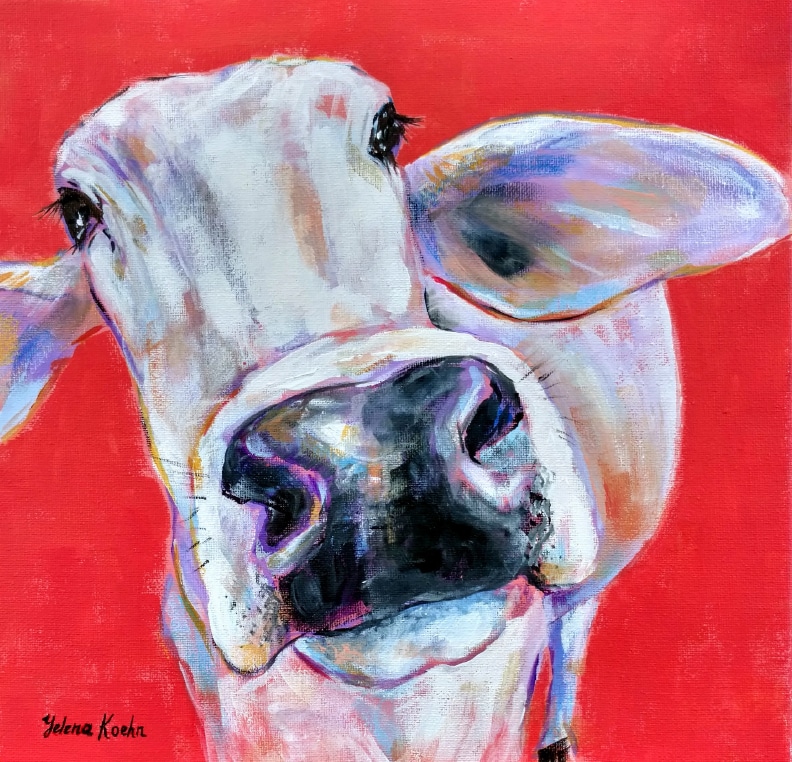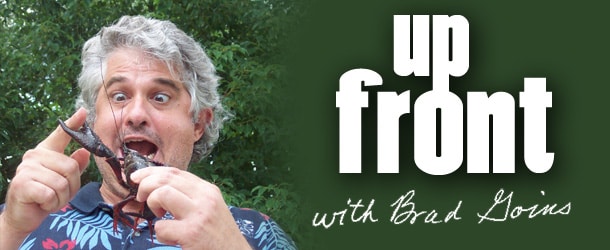Art work by Southwest Louisiana artist Yelena Koehn will be featured at the “Bovine And Buttercup” exhibit at RealArt DeRidder at 108 West 1st St. in DeRidder. Gallery hours are Wed.-Sat. from 11 am-3 pm. The gallery’s number is (337) 202-1089.
If you get this magazine when it first hits the stands, you’ll still have time to go to the opening reception on Friday, Aug. 4, from 5:30-8 pm.
The exhibit will stay on display till Aug. 31.

If you’re willing to drive to Orange, Texas, you can see a large display of America’s finest neoimpressionist artists — the Taos artists — in the “yellow gallery” at the Stark Museum. If you don’t want to drive to Orange, just go to Google images and type in “Henri-Edmond Cross.”
Koehn says that she thinks “neoimpressionism is the most impressive movement in the history of art.” Still, she says she doesn’t “do true neoimpressionism anymore.” She refers to her art as “relaxed realism.”
An acrylic and oil painting workshop by Koehn will take place Aug. 19 from 9 am-5 pm at RealArt DeRidder. Lunch will be provided; tuition will be $90. As the class is limited to 15, you’ll want to call ahead at (337) 853-6941.
The focus of the workshop will be on proper composition, proportion and value. Students will work with photographic examples to see how they can use under-painting and color overlapping to emphasize the subject of their art work.
Participants will be able to use a photo of a cow as a reference. Both acrylic and oil painting are fine. If you paint in oil, Koehn will provide acrylic paints for an underpainting. Painters should bring such painting basics as their palette; the colors white, yellow, red, blue and black; and their “favorite brushes” — in particular, a round size 6, a bright size 12 and 14, and a 1-inch or wider brush. Optional supplies are a flesh tint, alizarine crimson, French ultramarine and raw umber.
The Next Pop-Up Museum
The Up Fronter is again asking you to sort through your old mementos, photographs and documents to find materials for the Central Library’s next Pop-Up Museum in celebration of Lake Charles’ 150th anniversary.
The theme of the Aug. 19 Pop-Up Museum will be “Entertainment and Media.” Do you have old materials about night clubs, performers, concerts, record studios and related topics? Take them to the Central Library at 301 W. Claude St.
You’ll be able to see your materials on display with all the others from 11 am-1 pm on Aug. 19. If you feel like it, you can say a word or two about the items you brought. And of course, you can take them back home after the event.
Need to know more? Call 721-7116.
Throwing The T-Shirt In The Ring
Everyone is asking what mayoral candidate in New Orleans might be able to take a bite out of the city’s crime wave?
Could it be Fleurty Girl? Also known as Lauren LeBlanc Haydel, Fleurty Girl runs the Fleurty Girl: Everything New Orleans boutique in the Crescent City. She is now a candidate for mayor. Her pledge to N.O. voters is “‘Punny’ shirts for everyone!”
The Master Is Gone
Some people tell me I’m a pretty good writer. But nothing I can write can serve as an adequate eulogy for George Romero — the director who charted the course of the horror films of our time.
Since I can’t eulogize Romero, I’ll do something I don’t think many others will — present some of the powerful language in his scripts.
In 1968, Romero changed everything about horror with his unsettling masterpiece Night of the Living Dead. Even though the ostensible subject matter was something as outlandish as zombies, the movie’s look was starkly realistic and its characters presented all those unpleasant aspects of human behavior and tendencies that people so like to ignore.
Ten years later, Romero picked up the tale with Dawn of the Dead. A group of three men and one woman steal a helicopter and take up refuge in a shopping mall. As the woman, Francine, watches talking heads on the television bickering about doomsday, she says:
“It’s really all over … Isn’t it?”
At the end, only two of the group survive. As Francine climbs a ladder to make a desperate escape attempt in the helicopter, she has an unexpected dialogue with her fellow survivor.
Peter: Go on, get out of here.
Francine: Peter…
Peter: I said get out of here.
Francine: Peter…
Peter: I don’t want to go. I really don’t.
Romero’s third and final installment of the story came with the 1985 release of Day of the Dawn. A few surviving U.S. Army troops live in a huge underground military bunker, overseeing the efforts of several scientists to study the zombies. As officers are killed by attacking zombies, a private forcibly takes control of the project. The scientists (including Sarah) and two of the soldiers (including John) revolt against the strict Army discipline.
The soldier McDermott: You think I’m not aware of our situation? You think I want to stay isolated down here? You know, I’d make a desperate effort to raise somebody in hopes of getting away from your nasty mouth, [Private] Steel. But the fact is … either we’re the only ones left or there’s no one within range of my puny Second World War radio signals.
The soldier Johnson: We used to talk to Washington all the time. They could hear us then.
McDermott: We were on relays then. We weren’t over the air. The power is off on the mainland now, in case you haven’t heard. And all the shopping malls are closed.
Sarah asks the rebel soldier John if he has an alternative to her research on zombies.
John: I got an alternative; yeah, I got an alternative. Let’s get in that old [helicopter], find us an island some place, get juiced up and spend what time we got left soakin’ up some sunshine. How’s that?
Sarah: You could do that, couldn’t you? With all that’s going on, you could just do that without a second thought?
John: Right. I could do that even if all this wasn’t going on.
Their discussion continues:
John: I don’t believe in what you’re doing here, Sarah. Hey, you know what they keep down here in this cave? Man, they got the books and records of the Top 100 companies. They got the Defense Dept. budget down here. And they got the negatives for all your favorite movies. They got microfilm with tax returns and newspaper stories. They got immigration records, census reports and the accounts of all the wars and plane crashes and volcano eruptions and earthquakes and fires and floods and all the other disasters that interrupted the flow of things in the good ole U.S. of A. Now what does it matter, Sarah darling? All this filing and record-keeping? … This is a great, big, 14-mile [long] tombstone with an epitaph that nobody[’s] gonna bother to read. Now, here you come with a whole new set of charts and graphs and records. What you gonna do? Bury them down here with all the other relics of what once was? … I’m gonna tell you what else. You ain’t never gonna figure it out, just like they never figured out why the stars are where they’re at. It ain’t mankind’s job to figure that stuff out. So what you’re doing is a waste of time, Sarah. And time is all we got left, you know.
Sarah: What I’m doing … is all there is left to do.
John: Shame on you. There’s plenty to do. So long as there’s you and me and maybe some other people, we could start over, start fresh, get some babies … and teach ‘em, Sarah, teach ‘em never to come over here and dig these records out.
Romero was the sole author of both screenplays.
What In The World?
I find that I cannot imagine what in the world would inspire Paul McCartney — at the age of 75 — to put on a performance in Bossier City. (I do know this much — it’s not the money.)
Hey, Paul — excuse me — Sir Paul, I hear there are a couple of people in Bell City who’d be interested in seeing you perform. The outdoor stage of the 4H Club is free every Saturday night in August and September.
News
“Spoilers: ‘Game of Thrones’ heats up” — CNN headline, July 17.
“Check out the latest in the AP’s audio series on #GameofThrones.” — Associated Press, July 19.
“Why It’s OK to Start a TV Show in the Middle” — New York Times, July 26. I would give that last one the award for the silliest headline in history, but I have a feeling I gave that award away already. And one more thing, New York Times: the “to” in an infinitive should be capitalized — whether it’s in the middle, beginning or end of the headline.















Comments are closed.